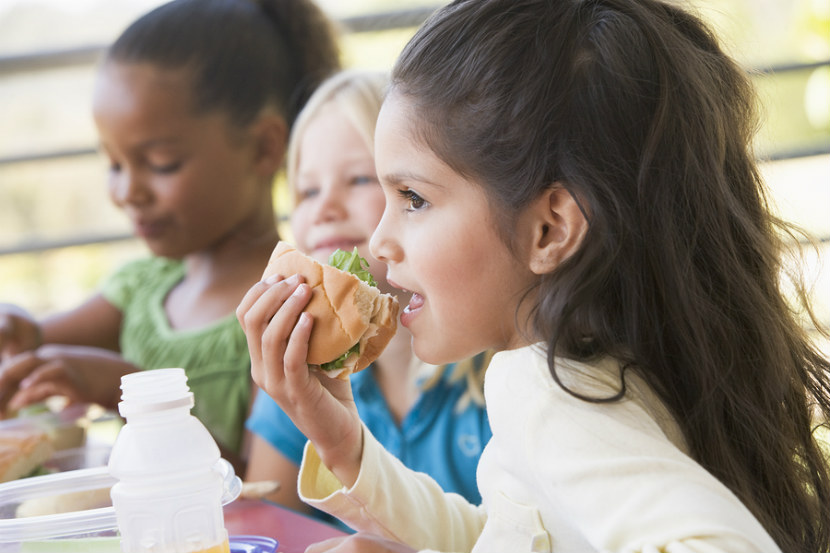
Food safety is essential to lower the risk of foodborne illness in children. Read on to learn how to prepare, cook, serve and store foods to help prevent foodborne illness.
Are children at higher risk for foodborne illness?
Yes. Children are at higher risk for foodborne illness because their immune systems are not fully developed to fight off infections. Children also make less stomach acid, which helps kill bacteria. Children five years of age and under are most at risk for foodborne illness. Read about the different types of foodborne illnesses.
How do I lower the risk of foodborne illness for my child?
Follow these food safety tips when preparing, cooking and storing foods:
Preparing food
When preparing raw meats, fish, shellfish, poultry and eggs:
-
Wash your hands with hot, soapy water for 30 seconds before and after you prepare these foods.
-
Use a separate cutting board to prepare these foods. Be sure to wash any plates or utensils that come in contact with these foods.
-
Don’t let your child touch these foods. For example, your child should not prepare raw hamburger patties, chicken strips, salmon or sausages.
-
Don’t let your child eat raw cookie dough or cake batter made with eggs.
When preparing vegetables and fruit:
-
Wash raw vegetables and fruit well.
-
Use a separate cutting board for these foods.
-
Not planning to eat the peel? You should still wash fruit and vegetables before peeling or cutting into them. This will prevent anything on the surface from getting on the knife and then contaminating the insides.
Cooking food
-
Cook all meat, fish, shellfish, poultry and eggs thoroughly. Your child should not eat these foods raw or undercooked.
-
Use a food thermometer and this chart for a list of safe temperatures.
Serving food
-
Keep hot foods hot (greater than 60°C/140°F) and cold foods cold (cooler than 4°C/40°F). Use a food thermometer to make sure foods are kept at these temperatures. Do not keep perishable food out at room temperature for longer than 2 hours.
-
Serve hot foods right away. If foods are too hot for your child, add an ice cube.
-
Serve small portions to your kids so food does not sit out. Offer a second helping if your child wishes to have more.
Storing food
-
Don’t let perishable foods sit out until they reach room temperature. Foods should be refrigerated within two hours or less.
-
Use clean containers to store all leftover foods. Avoid storing food portions that have been partly eaten.
-
Store fresh vegetables and fruit separately from raw meats, fish, shellfish or poultry. Keep raw foods on a lower shelf to avoid spillage onto other fresh foods.
-
Make sure your refrigerator is 4°C/40°F or below and your freezer is -18°C/0°F or below.
-
Keep a copy of the food handler’s storage guide handy.
Get more food safety tips for leftovers and freezing foods.
How do I keep my kids’ lunches food safe?
When packing a lunch or snack, keep these food safety tips in mind:
-
Keep hot foods, like soup, hot (greater than 60°C/140°F) by using a thermos. This is especially important if the food has meat, fish, shellfish, poultry or egg.
-
Keep cold foods, like yogurt, cold (4°C/40°F or cooler) by using travel size re-freezable ice packs. You can also freeze containers of yogurt or unsweetened applesauce.
-
Wash all fresh fruits before packing them in your child’s lunch box. Wrap them in a cloth or napkin to prevent bruising.
-
Encourage your child to wash their hands with soap and water before eating. If this isn’t possible, pack a travel size hand sanitizer in your child’s backpack and encourage them to use it before eating.
Are unpasteurized foods safe for my kids?
No. Unpasteurized foods like milk, cheese and honey put kids at risk for many types of foodborne illness. Learn more about pasteurization here.
Teaching your kids about food safety
Help kids be food safe with these tips:
-
Let kids cook with you in the kitchen and explain the steps you take to keep food safe.
-
Before mealtime preparation begins, give kids an apron, tie back long hair and have them wash their hands.
-
Encourage kids to wash their hands often. Hand washing is especially important before and after touching food, using the washroom, or touching a pet.
Learn more about cooking with kids here.
How can a dietitian help?
A dietitian will help ensure your child is getting important nutrients, like protein, fibre, iron and calcium, needed to grow and be healthy. Your dietitian will make suggestions on how to boost the nutrition of the foods they are already eating and give you a plan on how to introduce new ones. They can also help you plan school lunches with nutrition and food safety in mind. Connect with a dietitian today!
Bottom line
Following food safety practices when cooking and preparing food is essential for reducing the risk of foodborne illness in children. Having kids in the kitchen is fun, and can teach your child about nutritious foods and how to keep foods safe.
You may also be interested in:
Food Safety – True or False Quiz: Test Your Knowledge
Everyday Tips for Washing Vegetables and Fruit
Top 5 Reasons to See a Dietitian
This article was written and reviewed by dietitians from Dietitians of Canada. The advice in this article is intended as general information and should not replace advice given by your dietitian or healthcare provider.
Last Update – February 19, 2023